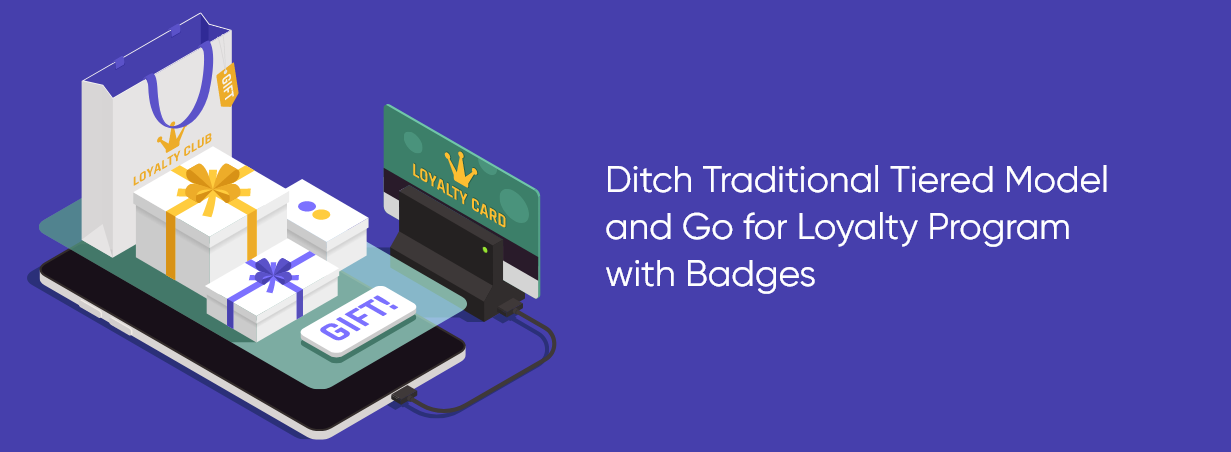Ditch Traditional Tiered Model and Go for Loyalty Program with Badges
- Posted on May 8, 2023 by Robert
- Reading time about 5 minutes
Customers today have high expectations, which means brands must prepare to keep up with evolving needs. Successful brands are the ones who build their customer loyalty programs with innovation, customization, collaboration, and sustainability in mind to drive incremental sales and profits in 2023 and beyond. Gone are the days when customers look out for tiered loyalty programs. Badges are now offering an innovative alternative to traditional tier-based loyalty programs.
Let’s check how you can build a Tiered based loyalty rewards program using badges to transform loyalty programs for the better.
Tiered Model vs. Badges Model
When we talk about the tiered model, we are referring to the program model where members progress to higher tiers based on factors like spending to unlock better offerings or special benefits of increasing value. On the other hand, the badges model here refers to the approach where members get to earn badges for their actions, and newer benefits are unlocked with every badge.
Badges can be more encouraging and less risky than tiers when it comes to loyalty program structure. The benefits of using badges include gamification potential, direct connection to desired behaviors, inclusivity & more.
Why Brands Must Go For Badges Loyalty Program Model?
In this section, we will check out the benefits of badges in loyalty programs and how brands can build stronger connections with their customers.
– Directly Associated with Desired Behaviors
Badges can be directly connected to specific customer behaviors that any brand is looking to stimulate in its loyalty program. The activity for which customers get badges can be anything such as purchasing specific products, attending exclusive events, or providing positive reviews.
Earning a badge in such normal activities can help in building a clear link between customers’ actions & their rewards, leading to a stronger sense of accomplishment, satisfaction, and brand affinity.
On the other hand, when we talk about tiered loyalty programs, rewards that customers get based on the amount being spent may not necessarily directly align with any set of behaviors the business wishes to support. Using the badge reward model helps brands get the freedom to choose any behavior they wish to reward customers.
– More Inclusive than Tiered Models
As compared to tiered frameworks, badges can be more inclusive as they enable rewards to be earned by customers at every spending level. Tiered-based programs only reward the high-spending customers with the best benefits. However, the case is different in terms of badges as they allow all customers to access value and be rewarded for engaging in different activities.
Using badges help to boost satisfaction and brand loyalty among a larger customer base, treating them equally in every aspect and being open to getting rewarded. This increases the retention rate and drives higher customer lifetime value.
– Flexibility for Program Operators
Another best thing about using the badges model in the rewards loyalty program is that it gives program operations the flexibility to consistently evolve with badge structure as the business and customer needs evolve with time.
However, in the case of tiered loyalty programs, it can be quite challenging to alter once established. The same is resolved in the badges program as it can be added, removed, or modified to align with changing priorities. This flexibility ensures that the loyalty program remains relevant and all-time engaging at all times for customers.
– Offer Opportunity for Gamification
As we know gamification is becoming the trending part of every loyalty program, it surely helps to engage loyalty program members to a huge extent. The application of game design elements to non-gaming contexts is what we mean by gamification and badges allow adding gamification within the loyalty program.
Badges can be highly appealing, collectible, and can be easily shared on social media platforms. This means badges can be earned easily in a fun and interactive way. Not just that, it allows users to showcase their achievements to their family and friends encouraging others to come join the loyalty program.
Examples of Top Badge-Based Loyalty Programs
1. Starbucks Odyssey
With this program, members complete multiple tasks to complete their journey and earn ‘Journey Stamps’, redeemable on perks. This provides better engagement and reward layers building a sense of competition and achievement among program users.
2. Fitbit Rewards
This renowned fitness tracker company makes use of badge-based programs where users are rewarded for reaching specific milestones in their fitness records. Offering badges for such activities help Fitbit to encourage users to stay active and keep them engaged.
3. Planet Brewdog
Using these programs, members provide badges by completing certain actions like placing orders or buying the latest products. This approach is beneficial as it drives not just the purchase frequency but also builds a like-minded community.
Closing Statement
After going through the blog, it is obvious that badges are gaining huge attention in the world of loyalty programs. As an alternative to tiered program models, badges can help to boost engagement and build customer loyalty for a longer time. You can do so by implementing gamification, rewarding certain behaviors, promoting inclusivity, and more.
If you are planning to add Loyalty Program Gamification Rewards for your customers, you have come to the right place. Novus is an all-in-one loyalty management platform that can help businesses to grow with custom-made programs leading to higher customer satisfaction &engagement to win customers’ hearts in the age of distraction.



